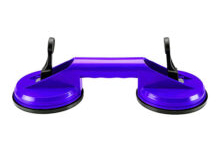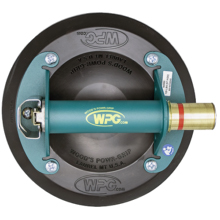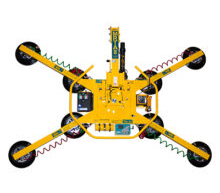Laurel, MT - Suction cups are versatile tools that can be used to lift, move, and hold a variety of materials, including insulated metal panels (IMPs). As a leading manufacturer/supplier in this field, Wood's Powr-Grip explains how suction cup lifters works and how to choose the right one.
By Wood's Powr-Grip
Suction cups are versatile tools that can be used to lift, move, and hold a variety of materials. They work by creating a vacuum between the cup and load's surface. The much higher pressure of the atmosphere then pushes down on the cup with incredible
force, creating a solid yet conveniently temporary connection.
Suction cup lifters are available in a variety of sizes, capacities, and surface applications. The type of lifter you need will depend on the weight of the material being lifted, the surface of the material, and the environment in which you are working.
How To Choose The Right Suction Cup Lifter
• Material: The suction cup lifter must be compatible with the material's surface. Standard suction cups are typically used for non-porous materials such as glass and metal. However, porous materials such as wood and concrete will require
specialized high-flow vacuum systems. You'll find suction cup lifters designed for a wide range of materials, such as textured finishes, stone, sheet metal, or delicate surfaces like low-e or silk-screened glass. (Insulated metal panel handling is shown in the accompanying photos.) Click here for a standard list of options.
• Weight and Size: The suction cup lifter must have the rated capacity to support the full weight of the load. You'll also need to consider the dimensions of the load. For larger loads, utilize lifters featuring additional vacuum pads or pads
spread further apart. This setup minimizes overhang and ensures adequate support during lifting.
• Environment: The suction cup lifter must be able to withstand the environmental conditions in which you are working. For example, you cannot use a suction cup lifter in a hot environment if it is not designed for high temperatures.
Types Of Suction Cup Lifters
There are three main types of suction cup lifters:
• Flip cups: These (example below) are the simplest type of suction cup lifter. They attach to the surface by pulling small levers, which creates a partial vacuum. Flip cups are less reliable than other types of suction cup lifters, as they
can pop off and drop a load without any warning. They are typically only used by hobbyists or workers in developing countries.

• Pump suction cups: These suction cups (example below) are more reliable than flip cups, and they are typically used by professionals. They have a built-in vacuum pump that creates a strong vacuum, and they feature a red-line low vacuum indicator
that shows when the cup needs to be repumped.

• Powered suction cup lifters: These suction cups (example below) are the most powerful type of suction cup lifter. They are typically mounted on cranes, hoists, or forklifts, and they can be used to lift a variety of large and heavy objects.

Pro Tips For Using Suction Cup Lifters
• Clean the surface before use. This will help to create a better seal between the cup and the surface.
• Verify approved uses in instructions or online specs. Lifters vary in capabilities for capacity, temperature, elevation, and more.
• Do not use suction cups on surfaces that are wet or oily. This will reduce the effectiveness of the vacuum.
• Store suction cups in a cool, dry place. This will help to extend their lifespan.
By following these tips, you can ensure that your suction cup lifter will work properly and safely.
Summary
Suction cup lifters are versatile tools that can be used for a variety of tasks. By understanding how they work and considering the factors mentioned above, you can choose the right suction cup lifter for your needs.
For information on suction cup lifters for metal panels from Wood's Powr-Grip, click here.